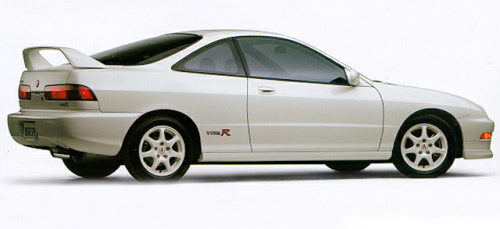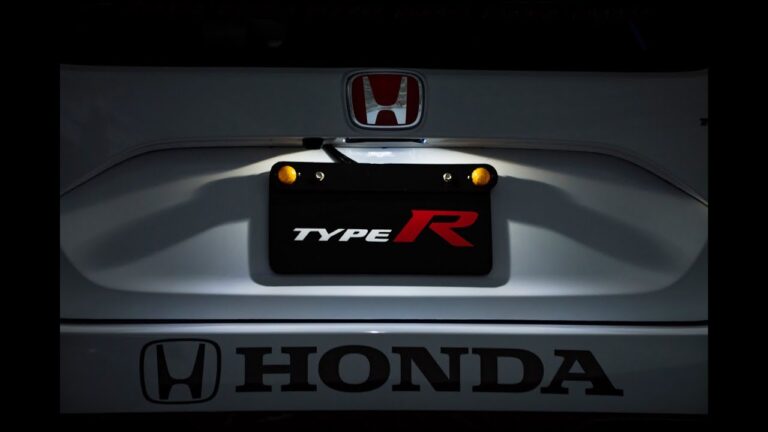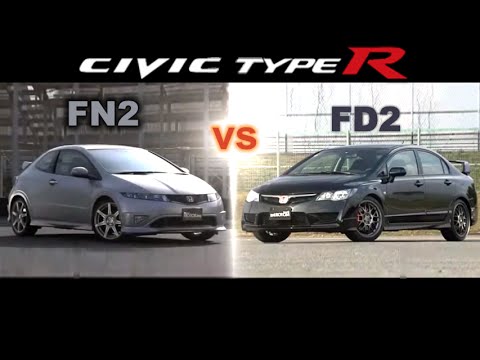1998 Acura Integra Type R Features
1998 Acura Integra B18C5 Engine Specification Highlights
The Integra Type R features an advanced 1.8-liter, 195-horsepower, dual overhead cam, 16-valve inline 4-cylinder engine equipped with the Variable Valve Timing and Lift Electronic Control (VTEC) system pioneered in the Acura NSX.
Its additional horsepower, which is 25 more than the 170-horsepower Acura Integra GS-R, is the result of key technological achievements including:
- High-compression, low-friction pistons;
- High-performance camshafts and valve gear;
- Larger throttle body and single-port intake manifold;
- Hand-polished intake and exhaust ports;
- High-volume induction and exhaust system.
The engine also features Programmed Fuel Injection (PGM-FI), a highly rigid crankshaft with eight full balance weights, a crankshaft reinforcing bridge, an oil cooling system and oil jet piston cooling, twin-spring intake and exhaust valves, a highly rigid integrated aluminum die-cast engine stiffener, and a number of other technologies to increase performance while maintaining reliability and durability, along with smooth operation.
| SPECIFICATIONS | . |
| Engine Type | 1.8-liter, 16-valve, DOHC VTEC inline 4-cylinder (B18C5) |
| Horsepower, SAE net | 195 hp @ 8000 rpm |
| Torque, SAE net | 130 lbs-ft @ 7500 rpm |
| Redline | 8400 rpm |
| Fuel Cutoff | 8500 rpm |
| VTEC Switchover | 5700 rpm |
| Bore & Stroke | 3.19 in x 3.43 in (81 mm x 87.2 mm) |
| Displacement | 110 cu in (1797 cc) |
| Compression Ratio | 10.6:1 |
| Induction System | Programmed Fuel Injection (PGM-FI) with single-port intake manifold |
| Valvetrain | 4 valves per cylinder, dual overhead camshafts driven by a single belt with Variable Valve Timing and Lift Electronic Control (VTEC) |
| Engine Block | Aluminum alloy with cast-in iron cylinder liners |
| Cylinder Head | Aluminum alloy |
| Emission Control | 3-way catalytic converter / EACV |
| Ignition System | Electronic ignition with knock sensor |
| Alternator | 85 amp. max. |
| Battery | 12V, maintenance-free |
| Recommended Fuel | Premium unleaded, 91 octane |
| Body Type | All-steel unit body |
| Front Suspension | Independent double-wishbone with coil springs, stabilizer bar |
| Rear Suspension | Independent double-wishbone with trailing link, coil springs and stabilizer bar |
| Shock Absorbers | Gas-pressurized with Honda Progressive Valve, front and rear |
| Stabilizer Bars | . |
| Front | Ball joint type, 0.94 in (24 mm) diameter |
| Rear | 0.87 in (22 mm) diameter |
| Steering Type | Variable power-assisted, rack-and-pinion with rotary-valve steering gear |
| Steering Ratio | 16.1:1 |
| Steering Wheel Turns, lock-to-lock | 2.98 |
| Turning Circle | 34.8 ft (10.6 m) |
| Wheels | 6.0 JJ x 15 cast-aluminum alloy |
| Tires | Bridgestone RE010 195/55 R15 84V |
| Braking System | Dual diagonal, power-assisted, 4-wheel disc brakes with ABS |
| Front Discs | Ventilated, 11.1 in (282 mm) diameter, 0.83 in (21 mm) rotor thickness |
| Rear Discs | 10.2 in (260 mm) diameter, .35 in (9 mm) rotor thickness |
| Swept Area | Front: 1478 cm2 Rear: 1095 cm2 |
| Parking Brake | Disc type, mechanically actuated on rear wheels |
| Anti-lock Braking System (ABS) | 3-channel system with 4 wheel-speed sensors and electronic/hydraulic control unit |
| . | . |
| POWERTRAIN | . |
| Type | Transverse-mounted front engine/front-wheel drive with equal-length driveshafts |
| Transmissions | . |
| Ratios (:1) | |
| 1st | 3.230 |
| 2nd | 2.105 |
| 3rd | 1.458 |
| 4th | 1.107 |
| 5th | 0.848 |
| Reverse | 3.000 |
| Final Drive | 4.400 |
| CAPACITIES | |
| Crankcase | 5.1 U.S. quarts (4.8 liters) refill capacity including filter |
| Cooling System | 7.1 U.S. quarts (6.7 liters) |
| Fuel Tank | 13.2 U.S. gallons (50 liters) |
| Volumes | |
| Passenger | 77.1 cu ft |
| Cargo | 13.3 cu ft |
| Total | 90.4 cu ft |
| FUEL ECONOMY | . |
| Factory Estimated Fuel Mileage, City/Highway* | 25 / 31 |
| * California figures are the same. | . |
| EXTERIOR DIMENSIONS | . |
| Wheelbase | 101.2 in (2570 mm) |
| Track, front | 58.3 in (1480 mm) |
| Track, rear | 58.1 in (1475 mm) |
| Length | 172.4 in (4380 mm) |
| Width | 66.7 in (1695 mm) |
| Height | 51.9 in (1320 mm) |
| Minimum Ground Clearance | 5.3 in (135 mm) |
| Curb Weight | 2577 lbs (1170 kg) |
| Weight Distribution (%) front/rear | 62/38 |
To get the most out of the engine’s added horsepower, the Type R also features a close-ratio, 5-speed manual transmission and a new limited-slip differential. The development emphasis was placed on dramatically increasing performance at high rpm. This emphasis resulted in an engine with a significantly different character than the Integra GS-R, further reinforcing the Type R’s image of a limited production, ultra-high-performance sports coupe.
Putting out 195 horsepower at 8000 rpm and 130 lbs-ft of torque at 7300 rpm, the Type R engine is the most powerful normally-aspirated mass-produced automobile engine per liter ever produced (108 horsepower per liter) for the United States. And its relatively long stroke and high redline give it the highest piston speed of any automobile engine in the world, even faster than the legendary World Championship Honda Formula One and IndyCar engines.
PISTONS AND CONNECTING RODS
Exclusive pistons and connecting rods have been developed for the Type R. The high-pressure die-cast piston crown has been reshaped to increase the compression ratio to 10.6:1, and valve pockets deepened to accommodate the increased valve lift and duration of the Type R.
The piston skirt is coated with molybdenum to minimize friction and allow it to withstand high-rpm operation, while specially designed oil paths have been machined into the underside of the piston to provide additional lubrication to the piston pin.
Extreme care was taken in the forging and machining of the connecting rods to ensure each engine of a precisely matched set of connecting rods. Like in the GS-R, the rods are constructed of special high-strength steel for a rigid yet lightweight component.
Extremely accurate machining of the Type R connecting rod minimizes variation between parts. Connecting rod bolt elongation has been strictly controlled for uniform fastening force. This is achieved through manual assemble of each and every connecting rod for the Type R, and the result is a significant reduction of fastening force variance.
The combination of lightweight pistons and connecting rods helps to reduce reciprocating inertia and enhance throttle response significantly.
ENGINE BLOCK AND CRANKSHAFT
The Type R utilizes a pressure die-cast aluminum alloy block with cast-iron cylinder liners for light weight and maximum rigidity. Its highly rigid crankshaft is made of forged, high-strength steel with eight full balance weights to reduce vibration at high rpm by 20 percent. The journals of the crankshaft also feature a special micro-polished surface finish for reduced friction and increased durability.
CYLINDER HEAD, VALVES AND CAMSHAFTS
The cylinder head design for the Type R is a double overhead camshaft, a four-valves-per-cylinder configuration that incorporates the exclusive VTEC system. The Type R engine utilizes the latest combustion technology to provide a combination of fuel efficiency and power.
Because of the low surface-to-volume area of the chamber, minimal surface area is exposed to the heat of combustion, and more heat is retained in the expanding gases, resulting in increased thermal efficiency. And the generous ‘squish’ area around the combustion chamber yields increased gas turbulence for faster flame propagation and even better efficiency.
Extensive modifications of the cylinder head were undertaken to improve performance. This also involves hand-polishing of the intake and exhaust ports near the valve seat area. In addition to hand polishing the ports to improve flow, special lightweight intake valves are also fitted.
These valves feature a thinner shaft to reduce weight and increase flow. The head of the valve is also lightened to further reduce valvetrain weight. These modifications net a 12 percent weight reduction of the intake valves, allowing the engine to rev higher. These lighter intake valves help extend the rpm range of the Type R engine by an additional 200 rpm.
Special high-performance dual intake valve springs with an oval-shaped cross-section are utilized to allow the use of high-performance camshafts for increased flow at high rpm. The unique oval shape allows a stronger valve spring to be fitted in the same area as a conventional spring.
Conventional dual high-performance valve springs are used on the exhaust valves.
Camshafts fitted to the Integra Type R are longer duration with a higher lift to help increase engine breathing and top-end horsepower. At high engine speeds, valve lift on the intake side is increased by 0.9 mm, and on the exhaust side by 1.1 mm, compared to the GS-R.
The valve timing is extended an additional 10 degrees on the intake side and 8 degrees on the exhaust side.
VARIABLE VALVE TIMING AND LIFT ELECTRONIC CONTROL (VTEC) SYSTEM
The VTEC system, first pioneered in the Acura NSX, works similar performance magic in the Integra Type R.
As the performance of the NSX has already amply demonstrated, VTEC is an innovative solution to an age-old automotive engineering problem. It elegantly solves the trade-off between tuning an engine for either high-end horsepower or low-end torque. With VTEC, Acura engineers no longer have to compromise between the two. VTEC-equipped engines can have the best of both.
The VTEC system uses three cam lobes and three corresponding rocker arms for each pair of valves. The VTEC system operates on both the intake and exhaust valves. The two outer cam lobes have a profile that optimizes low-speed torque and response. The middle lobe has a high-lift, longer-duration profile that is designed to optimize high-end horsepower.
The switchover point between low lift and high lift in the Type R is 5700 rpm (compared to 4400 rpm on the GS-R), for excellent midrange torque. This makes the Type R engine responsive under all operating conditions, and especially when going from part-throttle, steady-state cruising to full throttle.
THROTTLE BODY/ INTAKE MANIFOLD/ AIR INTAKE
In the interests of high rpm, high output and weight reduction, the Type R utilizes a large-diameter throttle body and exclusive single-port intake manifold. The throttle bore has been increased by 2 mm to 62 mm and the intake runners have increased 7 mm in diameter from 35mm to 42 mm to increase intake flow, especially at high-rpm dramatically.
The cast aluminum intake manifold features a large-diameter, single intake runner for each cylinder with a short, direct path to the cylinder head for maximum high-rpm efficiency. The single-port design also results in a 3.2 kg weight savings.
Also, the fuel injectors point almost directly toward the center of the intake valves, helping to reduce fuel condensation on the intake port walls and improving driveability and engine response. To ensure a large amount of cool, fresh intake air, the air inlet has been moved from the engine compartment to an area behind the left-front fender.
OIL JET PISTON COOLING
To help ensure long-term durability and reliability, the Type R engine uses an oil-jet piston cooling system. A jet of pressurized engine oil is directed to the underside of the piston to help dissipate the extreme heat generated during sustained high-rpm operation. This technology has proven itself in Formula One and other top-level racing engines.
ENGINE OIL COOLER
To maintain optimum engine oil temperature, the Type R features an aluminum oil cooler for maximum heat dissipation and thermal efficiency. The aluminum cooler is mounted on the engine block.
SURFACE-ORIENTED CRYSTAL-BEARING MATERIAL
The use of a surface-oriented crystal-bearing material was pioneered in Formula One racing and has been adapted for use in the Type R engine. Unlike the surface of conventional-bearing material, the crystal-bearing surface has molecules oriented into a pyramid shape. This surface traps a layer of oil and holds it far better than conventional bearing surfaces, reducing friction and enhancing reliability.
EXHAUST SYSTEM
A major contributor to the Type R’s ability to generate 195 horsepower from only 1.8 liters displacement is its highly efficient exhaust system. The exhaust flow rate has been increased by 30 percent over the Integra GS-R model thanks to a number of improvements.
Starting with a large-diameter Tri-Y header system, the individual head pipes gently converge into a tapered collector to provide smooth flow with minimum obstruction. The stainless steel header connects to a free-flowing exhaust system with significantly increased pipe diameters, the addition of a third exhaust chamber, and a performance-oriented muffler with a large NSX-style exhaust tip.
5-SPEED MANUAL TRANSMISSION
The main design goals of the Type R close-ratio transmission were to take full advantage of the additional high-rpm power and provide smooth, seamless shifting.
The close-ratio transmission used in the Type R model features different ratios, bearing design, and clutch than the GS-R. The differences were necessary to handle the higher output of the Type R engine and to extract maximum acceleration and performance from the 195 horsepower engine.
Like other Integra models, the Type R features a short-stroke shift linkage of exceptional rigidity. The system approaches the quality feel and short stroke of the Acura NSX shift linkage system.
For improved throttle response, the Type R utilizes a special lightweight flywheel coupled with a heavy-duty, hydraulically actuated clutch.
The Type R also employs a uniquely integrated aluminum die-cast engine stiffener for improved engine-to-transmission fastening rigidity to cope with additional engine output and high rpm. Vibration is reduced 22% compared to the traditional separate fore and aft fastening systems.
The Type R, like all Integra models, features equal-length halfshafts, which virtually eliminate torque steer.
HELICAL LIMITED-SLIP DIFFERENTIAL
Working in combination with a suspension setting designed to enhance front-wheel grip, the Type R adopts a torque-sensitive helical type limited slip differential (LSD) for both improved traction and reduced understeer in high-cornering load situations.
The helical gear generates repelling force in proportion to driving torque. This repelling force, in turn, pushes the pinion gear toward the differential gear casing, thus limiting the differential effect. Compared to viscous coupling-type limited slip differentials, helical limited slip differentials offer a more responsive, proactive torque transfer.
This allows improved traction not only when exiting tight corners but also when on slippery or uneven (undulated) road surfaces.







